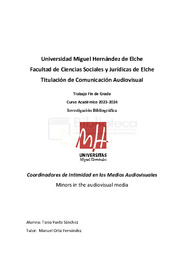Por favor, use este identificador para citar o enlazar este ítem:
https://hdl.handle.net/11000/33504Registro completo de metadatos
| Campo DC | Valor | Lengua/Idioma |
|---|---|---|
| dc.contributor.advisor | Ortiz Fernández, Manuel | - |
| dc.contributor.author | Yunta Sánchez, Tania | - |
| dc.contributor.other | Departamentos de la UMH::Ciencias Sociales y Humanas | es_ES |
| dc.date.accessioned | 2024-10-15T09:30:46Z | - |
| dc.date.available | 2024-10-15T09:30:46Z | - |
| dc.date.created | 2024-06 | - |
| dc.identifier.uri | https://hdl.handle.net/11000/33504 | - |
| dc.description.abstract | En el presente trabajo se analiza la figura de los coordinadores de intimidad en los medios audiovisuales desde los inicios de la representación de la sexualidad en el cine, la mujer y los primeros desnudos hasta la actualidad. En este sentido, mientras que no se ha tenido la ayuda de estos profesionales, los actores se han tenido que enfrentar a duros desafíos. Lo que se busca en esta investigación es dar a conocer esta nueva profesión porque se tiene una visión errónea. No se centra en sobreproteger a las actrices, ni en quitar libertad, sino que atienden y cuidan, toda vez que son mediadoras y comunicadoras entre el equipo y los protagonistas. Su presencia en los sets de rodajes garantiza la seguridad y el bienestar de los actores durante las escenas que implican sexualidad, desnudez, etc. Por tanto, manifestar su evolución es fundamental para enseñar los beneficios que aporta la presencia de este reciente rol en la industria cinematográfica. Todavía parte de la sociedad no acepta esta figura de la misma manera, puesto que la perciben como policías y la asocian a una restricción de la libertad. Sin embargo, profesionales como Tábata Cerezo y Lucía Delgado, pioneras en la coordinación de intimidad y actrices, hablan desde su experiencia de la necesidad de tener un rol tan importante, ya que ayudan a crear un espacio de trabajo más ético y profesional, mientras se proporciona confianza, consentimiento y comunicación. Por tanto, se puede concluir que todavía existen situaciones incómodas en los rodajes donde los actores pueden sentir vulnerabilidad. Aun así, es notable el cambio de la sexualidad en los medios, puesto que se solía actuar desde una visión cosificada, tratando a los sujetos como objetos y con el paso de tiempo, representa la sexualidad de manera más variada con un ambiente respetuoso para los involucrados. | es_ES |
| dc.description.abstract | The figure of intimacy coordinators in the audiovisual media is analyzed from the beginnings of the representation of sexuality in cinema, women and early nudity to the present day. While there has been no help from these professionals, the actors have had to face tough challenges. What is sought in this research is to raise awareness of this new profession because it has an erroneous vision. It does not focus on overprotecting the actresses, nor on taking away freedom, but they attend and take care, while they are mediators and communicators between the crew and the protagonists. Their presence on film sets ensures the safety and well-being of the actors during scenes involving sexuality, nudity, etc. Therefore, demonstrating their evolution is essential to show the benefits of the presence of this recent role in the film industry. Still part of society does not accept this figure in the same way, since they perceive them as policemen and as a restriction of freedom. However, professionals such as Tábata Cerezo and Lucía Delgado, pioneers in the coordination of intimacy and actresses, speak from their experience of the need to have such an important role, since they help to create a more ethical and professional work space, while providing trust, consent and communication. Therefore, it is concluded knowing that there are still uncomfortable situations on shoots where actors may feel vulnerable. Even so, it is remarkable the change of sexuality in the media, since it used to act from a reified vision, treating the subjects as objects and with the passage of time, it represents sexuality in a more varied way with a respectful environment for those involved. | es_ES |
| dc.format | application/pdf | es_ES |
| dc.format.extent | 29 | es_ES |
| dc.language.iso | spa | es_ES |
| dc.publisher | Universidad Miguel Hernández de Elche | es_ES |
| dc.rights | info:eu-repo/semantics/openAccess | es_ES |
| dc.rights | Attribution-NonCommercial-NoDerivatives 4.0 Internacional | * |
| dc.rights.uri | http://creativecommons.org/licenses/by-nc-nd/4.0/ | * |
| dc.subject | Sexualidad | es_ES |
| dc.subject | coordinador de intimidad | es_ES |
| dc.subject | desnudos | es_ES |
| dc.subject | bienestar | es_ES |
| dc.subject | seguridad | es_ES |
| dc.subject | Sexuality | es_ES |
| dc.subject | intimacy coordinator | es_ES |
| dc.subject | nudity | es_ES |
| dc.subject | wellness | es_ES |
| dc.subject | security | es_ES |
| dc.subject.other | CDU::7 - Bellas artes::77 - Fotografía. Cinematografía | es_ES |
| dc.title | Coordinadores de Intimidad en los Medios Audiovisuales | es_ES |
| dc.title.alternative | Minors in the audiovisual media | es_ES |
| dc.type | info:eu-repo/semantics/bachelorThesis | es_ES |

Ver/Abrir:
CAU_TFG_YUNTA_SÁNCHEZ_TANIA.pdf
874,97 kB
Adobe PDF
Compartir:
 La licencia se describe como: Atribución-NonComercial-NoDerivada 4.0 Internacional.
La licencia se describe como: Atribución-NonComercial-NoDerivada 4.0 Internacional.
.png)